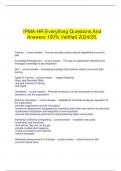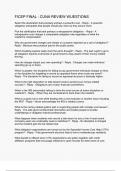IPMA-HR Everything Questions And
Answers 100% Verified 2024/25.
Training - correct answer. Process whereby people acquire capabilities to perform
jobs
Knowledge Management - correct answer. The way an organization identifies and
leverages knowledge to be competitive
20% - correct answer. Average percentage that a learner retains one month after
training
Types of Training - correct answer. -Legally Required
-Basic and Remedial Skills
-Job and Technical Training
-Soft Skills
Orientation - correct answer. Planned introduction of new employees to their jobs,
coworkers, and the organization
Effective Orientation - correct answer. -establishes favorable employee impression of
the organization
-provides organization and job information
-enhances interpersonal acceptance by coworkers and builds new network of resources
-accelerates socialization and integration of new employee
-ensures that employee performance and productivity begin more quickly
Elements of Effective Onboarding - correct answer. -establish clear goals
-know what new hires want
-start before "day one" on the job
-provide multiple short sessions
-create connections and networks
-make it enjoyable
Orientation Measurement of Success - correct answer. -tenure turnover rate
-new hire failure factor
,-employee upgrade rate
-development program participation rate
Instructional Systems Design (ISD) - correct answer. A step-by-step process to
ensure that the right learning materials are provided to the right people at the right time.
ADDIE Model - 5 Phases of Training - correct answer. Assessment, Design,
Development, Implementation, Evaluation
Key to Training Assessment - correct answer. Identifying gaps in performance
Effective Training Planning - correct answer. -is there really a need for the training?
-who needs to be trained?
-who will do the training?
-what form will the training take?
-how will knowledge be transferred to the job?
-how will the training be evaluated?
4 Ways to Effectively Train Employees - correct answer. 1-Blend in-person training
and online training
2-Provide hands-on training
3-Incorporate mobile training apps
4-Allow employees to learn at their own pace
How to Diagnose Training - correct answer. Analyze organizational outcomes and
look at future organizational needs
4 Ways to Measure Training Effectiveness - correct answer. 1-Learner reaction
2-Measuring gain in knowledge or skill
3-Measuring increased performance back in the workplace
4-Impact on the organization itself
Sources of Information for Needs Assessment - correct answer. -organizational
analysis
-job/task analysis
-individual analysis
Organizational Analysis - correct answer. Grievances, accidents, waste/scrap, training
observations, customer complaints, exit interviews, equipment use, attitude surveys
Job/Task Analysis - correct answer. Employee KSAs, benchmarks, effectiveness, job
specs, efficiency data, employee surveys
Individual Analysis - correct answer. Performance appraisals, tests, records,
assessment centers, questionnaires, surveys, job knowledge tools
,Focuses for Training Objectives - correct answer. -knowledge
-skill
-attitude
Training Design Elements - correct answer. -learner characteristics
-training transfer
-instructional strategies
Learner Characteristics - correct answer. Ability to learn, motivation to learn, self-
efficacy, perceived utility/value, learning styles
Training Transfer - correct answer. Overview of training content, strategic link,
supervisor support, opportunity, accountability
Instructional Strategies - correct answer. Practice/feedback, over-learning, behavioral
modeling, error-based examples, reinforcement/immediate confirmation
Self-Efficacy - correct answer. People's belief that they can successfully learn the
training program content
Andragogy - correct answer. Adult learning; ways in which adults learn differently than
do younger people.
5 Principles for Designing Training for Adults - correct answer. -need to know why
they are learning something
-need to be self-directed
-bring more work-related experiences into the learning process
-enter into a learning experience with a problem-centered approach to learning
-are motivated to learn by both extrinsic and intrinsic factors
Active Practice - correct answer. Trainees perform job-related tasks and duties during
training
Behavioral Modeling - correct answer. Copying someone else's behavior
Reinforcement - correct answer. Based on the idea that people tend to repeat
responses that give them some type of positive reward and to avoid actions associated
with negative consequences
Immediate Confirmation - correct answer. Based on the idea that people learn best if
they receive reinforcement and feedback as soon as possible after training
Training Delivery Options - correct answer. -internal to the organization
-external to the organization
, Internal Training Options - correct answer. Traditional classes, on-the-job training,
self-guided training at company portal, mentoring/coaching, job shadowing, developing
teachers internally, cross training, training projects, group-based classroom
External Training Options - correct answer. Third-party delivered training, web
conferences, training at outside location, podcasts, educational leave, blended training,
teleconferencing
Advantages to External Training - correct answer. Less expensive, less time to
develop internal training, staff may not have the level of expertise needed, employees
can learn from other companies
Informal Training - correct answer. Training that occurs through interactions and
feedback among employees
Common Forms of Instructional Techniques - correct answer. -on-the-job training
-apprenticeships
-simulations
-case studies
-games and activities
-role play
-behavior modeling
-computer-based training
On-The-Job Training - correct answer. The most common training because it is
flexible and relevant
Cross-Training - correct answer. Training people to do more than one job
Apprentice Training - correct answer. Provides employee with on-the-job experience
under the guidance of a skilled and certified worker
Case Studies - correct answer. Focus upon stories about individuals, organizations,
processes, projects or events and the consequence of decisions or actions that were
taken
Role Play - correct answer. Enables the practice of new skills in a safe environment,
open communication among participants, mandate active involvement, build individual
and group confidence, develop camaraderie among participants and enable the
correcting of errors while still in the classroom
Internship - correct answer. Combines job training with classroom instruction from
high schools, technical school, colleges and universities
E-Learning - correct answer. Use of web-based technology to conduct training online





